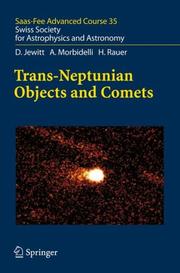| Listing 1 - 5 of 5 |
Sort by
|

ISBN: 9780511536090 9780521800198 9781107402614 0511012632 9780511012631 0511032145 9780511032141 0521800196 0511536097 0521800196 1280430206 9781280430206 1107402611 9781139428774 1139428772 0511303351 9780511303357 0511173849 9780511173844 0511153082 9780511153082 9786610430208 6610430209 1107122392 051104741X Year: 2001 Publisher: Cambridge Cambridge University Press
Abstract | Keywords | Export | Availability | Bookmark
 Loading...
Loading...Choose an application
- Reference Manager
- EndNote
- RefWorks (Direct export to RefWorks)
This book was originally published in 2001. In the ten years preceding publication, the known solar system more than doubled in size. For the first time in almost two centuries an entirely new population of planetary objects was found. This 'Kuiper Belt' of minor planets beyond Neptune revolutionised our understanding of the solar system's formation and finally explained the origin of the enigmatic outer planet Pluto. This is the fascinating story of how theoretical physicists decided that there must be a population of unknown bodies beyond Neptune and how a small band of astronomers set out to find them. What they discovered was a family of ancient planetesimals whose orbits and physical properties were far more complicated than anyone expected. We follow the story of this discovery, and see how astronomers, theoretical physicists and one incredibly dedicated amateur observer came together to explore the frozen boundary of the solar system.
Kuiper Belt. --- Belt, Kuiper --- Edgeworth Belt --- Edgeworth-Kuiper Belt --- Trans-Neptunian Belt
Book
ISBN: 0128175257 0128164905 9780128175255 9780128164907 Year: 2020 Publisher: Amsterdam, Netherlands
Abstract | Keywords | Export | Availability | Bookmark
 Loading...
Loading...Choose an application
- Reference Manager
- EndNote
- RefWorks (Direct export to RefWorks)
Kuiper Belt. --- Belt, Kuiper --- Edgeworth Belt --- Edgeworth-Kuiper Belt --- Trans-Neptunian Belt --- Outer planets. --- Gas giants --- Jovian planets --- Planets
Book
ISBN: 9780511761706 9780521194365 9781139190077 1139190075 0511761708 1139185179 9781139185172 0521194369 1107204739 1139179217 1283378310 9786613378316 1139188763 1139187481 1139182854 Year: 2010 Publisher: New York Cambridge University Press
Abstract | Keywords | Export | Availability | Bookmark
 Loading...
Loading...Choose an application
- Reference Manager
- EndNote
- RefWorks (Direct export to RefWorks)
"Orbiting at the edge of the outer Solar System, Pluto is an intriguing object in astronomy. Since the fascinating events surrounding its discovery, it has helped increase our understanding of the origin and evolution of the Solar System, and raised questions about the nature and benefits of scientific classification. This is a timely and exciting account of Pluto and its satellites. The author uses Pluto as a case study to discuss discovery in astronomy, how remote astronomical bodies are investigated, and the role of classification in science by discussing Pluto's recent classification as a dwarf planet. Besides Pluto, the book also explores the rich assortment of bodies that constitute the Edgeworth-Kuiper Belt, of which Pluto is the innermost member. Richly illustrated, this text is written for general readers, amateur astronomers and students alike. Boxed text provides more advanced information especially for readers who wish to delve deeper into the subject"--
Pluto (Dwarf planet) --- Solar system --- Kuiper Belt. --- Belt, Kuiper --- Edgeworth Belt --- Edgeworth-Kuiper Belt --- Trans-Neptunian Belt --- Pluto (Planet) --- Origin.

ISBN: 1281118044 9786611118044 354071958X 3540719571 3642091091 Year: 2008 Publisher: Berlin ; New York : Springer,
Abstract | Keywords | Export | Availability | Bookmark
 Loading...
Loading...Choose an application
- Reference Manager
- EndNote
- RefWorks (Direct export to RefWorks)
In the last two decades of the 20th century, we obtained our first detailed look at a cometary nucleus and detected objects in the Kuiper-Edgeworth Belt for the first time. These two observations have resulted in a major leap forward in our understanding of small bodies in our Solar System. Combined with powerful new approaches to the study of Solar System dynamics, progress within the last 20 years has been staggering. This book attempts to synthesize these new findings in a manner which is readable for new graduate students in the field.
Trans-Neptunian objects --- Comets --- Kuiper Belt --- Belt, Kuiper --- Edgeworth Belt --- Edgeworth-Kuiper Belt --- Trans-Neptunian Belt --- TNOs (Trans-Neptunian objects) --- Transneptunian objects --- Astronomy. --- Astrophysics. --- Astrobiology. --- Astronomy, Astrophysics and Cosmology. --- Space Sciences (including Extraterrestrial Physics, Space Exploration and Astronautics). --- Astrobiology --- Biology --- Habitable planets --- Life --- Astronomical physics --- Astronomy --- Cosmic physics --- Physics --- Origin --- Space sciences. --- Science and space --- Space research --- Cosmology --- Science
Book
ISBN: 1441927980 0387895175 9786612036163 1282036165 0387895183 Year: 2009 Publisher: New York : Springer,
Abstract | Keywords | Export | Availability | Bookmark
 Loading...
Loading...Choose an application
- Reference Manager
- EndNote
- RefWorks (Direct export to RefWorks)
The New Horizons mission provides the first in situ reconnaissance of the Pluto-Charon System and the Kuiper belt, arguably the last frontier of solar system exploration. This book describes the mission, its objectives, expected results, and instruments in articles written by the scientists and engineers most closely involved. The New Horizons mission is expected to return unique observations and discoveries, which will revolutionize our understanding of the formation of the solar system. This volume is aimed at researchers and graduate students active in planetary science and space exploration, and all other potential users of data obtained by the instruments on board the New Horizons mission.
Charon (Satellite). --- Kuiper Belt. --- Planets --Exploration. --- Pluto (Dwarf planet). --- Planets --- Astronomy - General --- Aeronautics Engineering & Astronautics --- Astrophysics --- Mechanical Engineering --- Astronomy & Astrophysics --- Physical Sciences & Mathematics --- Engineering & Applied Sciences --- Exploration --- Space probes. --- Trans-Neptunian objects. --- New Horizons (Spacecraft) --- TNOs (Trans-Neptunian objects) --- Transneptunian objects --- Deep space probes --- Probes, Space --- Physics. --- Planetology. --- Astronomy. --- Astrophysics. --- Cosmology. --- Observations, Astronomical. --- Astronomy --- Space sciences. --- Aerospace engineering. --- Astronautics. --- Astronomy, Astrophysics and Cosmology. --- Astronomy, Observations and Techniques. --- Aerospace Technology and Astronautics. --- Extraterrestrial Physics, Space Sciences. --- Observations. --- Space vehicles --- Space Sciences (including Extraterrestrial Physics, Space Exploration and Astronautics). --- Astronomical physics --- Cosmic physics --- Physics --- Space sciences --- Aeronautics --- Astrodynamics --- Space flight --- Planetary sciences --- Planetology --- Astronomy—Observations. --- Astronomical observations --- Observations, Astronomical --- Science and space --- Space research --- Cosmology --- Science --- Aeronautical engineering --- Astronautics --- Engineering --- Pluto (Dwarf planet) --- Charon (Satellite) --- Belt, Kuiper --- Edgeworth Belt --- Edgeworth-Kuiper Belt --- Trans-Neptunian Belt --- Pluto (Planet) --- Satellites
| Listing 1 - 5 of 5 |
Sort by
|

 Search
Search Feedback
Feedback About UniCat
About UniCat  Help
Help News
News